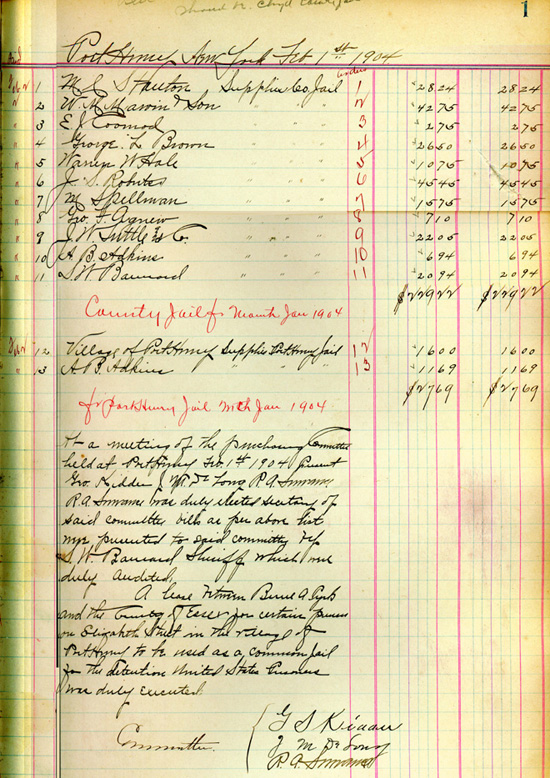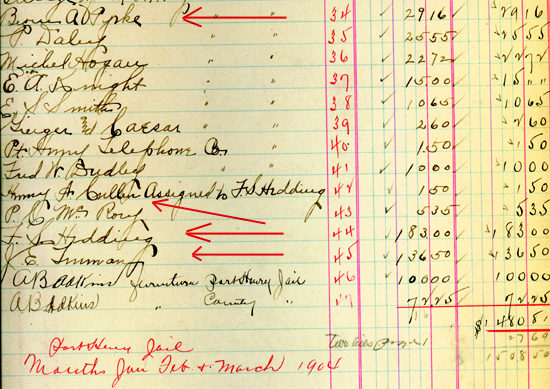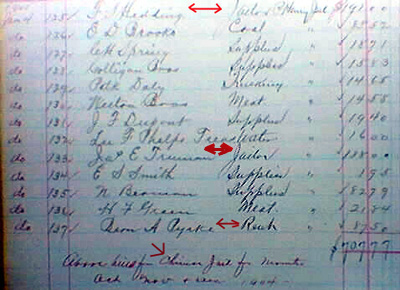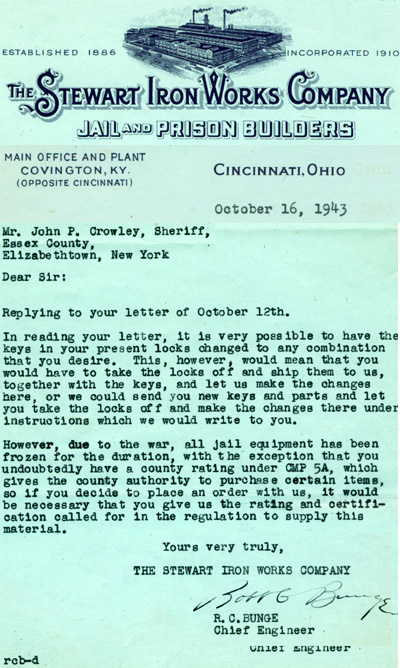In connection with the anticipated opening of a new Essex County Jail in Lewis, N. Y., during the summer of 2007, the New York Correction History Society (NYCHS) created this "virtual tour" of pre-computer record keeping at the county's old jail in Elizabethtown. This part of the tour examines the expenses or purchases audit book (left) maintained by a three-member Purchasing Committee of the Essex County Board of Supervisors tracking the operating costs for the county jails from Feb. 1, 1904 through April 24, 1931.
The operating expenses ledger is one of three jail ledgers made available to NYCHS by Major Richard Cutting, Essex County Jail Administrator since 1977.
One of its most intriguing aspects is the repeated use of the
phrase “Chinese Jail” among the entries made during the first decade of
the 20th Century.
It appears no fewer than 10 times beginning in 1904.
The first use is found on numbered Page 13 under the heading “Port
Henry, N. Y., Dec. 3rd, 1904.” The first six entries are the names of individuals submitting bills (Byron A. Perry, Ward Bras, Ida McDougal, M. C. Stanton, W. W. Hale, Orlando Beede).
The seventh entry on that page (right) reports the $3
payment
of a bill submitted by the Port Henry Telephone Co. for service during
November, 1904, at the “Chinese Jail.”
A clue to how the phrase may have evolved appears on the preceding
numbered page, all of whose entry lines had two crisscrossing red ink
lines drawn through them.
A notation explains “Above acct. transferred
to cash report book.” Even though the data entered under the
heading “S. W. Barnard, Sheriff, Essex Co.” was transferred elsewhere,
the crisscrossed information is quite readable and most useful in
tracking the phrase’s evolution.
A sequence of eight entries by Sheriff Barnard on numbered Page 12 (two images right, red arrow added to second image for emphasis) -- two
written out in full and the rest ditto marks – concerned $3,133.35
expenses involved in “Boarding Chinese Prisoners at Port Henry Jail,”
The eight entries cover the period from April 6 through Nov. 18, 1904.
In addition to Page 13, the phrase “Chinese Jail” appears on numbered
-
Page 14 dated Jan. 3, 1905),
- Page 17 dated March 31, 1905,
- Page 45
dated Aug. 2, 1907,
- Page 50 dated Jan. 2, 1908,
- Page 51 dated Feb. 15,
1908,
- Page 52 dated April 7, 1908,
- Page 53 dated July 10, 1908,
- Page
55 dated Nov, 11, 1908, and lastly
- Page 59 dated April 7, 1909.
Almost without exception, wherever that phrase appears, two names also
are listed among the entries:
- Berne A. Pyrke for “rent” and
- F. S.
Hedding as “jailor” or “keeper.”
Their names also appear with the same regularity in the listings of
expenses for “the Port Henry Jail.”
Pyrke’s name debuts in the ledger
on numbered Page 1 (Feb. 1st, 1904) in the last paragraph of the opening
report in the ledger by the three-man Purchasing Committee auditing the
expenses of Sheriff S. W. Barnard:
 Click image for full 550-point wide version, as per "Expand Images" box instructions right. Use back button to return to this page. Click image for full 550-point wide version, as per "Expand Images" box instructions right. Use back button to return to this page. |
“A lease between Berne A. Pyrke and the County of Essex for a certain
premises on Elizabeth Street in the Village of Port Henry to be used as
a common jail for the detention of United States Prisoners was duly
executed.”
EXPAND IMAGESBeginning left, selected ledger images are reduced versions of larger JPGs. Click the reduced version on this page to have your browser bring up the wider JPG. Use your browser's expand image icon  (example right: IE expand image icon)
to expand that JPG to its full width. Use the browser's "back" button to return to this page. (example right: IE expand image icon)
to expand that JPG to its full width. Use the browser's "back" button to return to this page.
|
|
The same page contains two entries related to the “Port Henry Jail.”
One lists $16 to the Village of Port Henry for supplies. The other lists $11 to A.
B. Adkins, also for supplies.
Among the crisscrossed Page 12 entries by
Sheriff Barnard are two identifying A. B. Adkins as “ex-sheriff.”
Numbered Page 2 (March 1st, 1904) includes the following report (left, red arrows added to image for emphasis) by the
Purchasing Committee:
“[The] Committee, also S. W. Barnard, Sheriff, visited new building for
the detention of U.S. Prisoner.
“[We] thought it to answer all requirements for which it was designed.”
Jailor Hedding makes his ledger debut on numbered Page 3 (April 5,
1904) as one of the entries on a long list of expenses for the “Port
Henry Jail.”
Landlord Pyrke’s name also appears again.
Two other names worth mentioning also make their appearance in the Page 3 Port Henry Jail entries. One is "Henry A. Cullen, Assigned to F. S. Hedding." The other is James E. Truman.
Thereafter, Cullen's name seems to disappear from the ledger, but Truman's appears with some regularity in the Port Henry Jail/Chinese Jail listings. Sometimes just his name, like Hedding's, appears without any descriptive note at all or with only a generic reference "Labor."
 Click image for full 550-point wide version, as per "Expand Images" box instructions above. Red arrows added to image for emphasis. Use back button to return to this page. Click image for full 550-point wide version, as per "Expand Images" box instructions above. Red arrows added to image for emphasis. Use back button to return to this page. |
But in six places the Truman references are job specific:
- Page 6, July 5, 1904 -- Night Watchman.
- Page 10, Oct.4, 1904 -- Watchman.
- Page 14, Jan.3, 1905 -- Jailor.
- Page 17, March 31, 1905 -- Watchman.
- Page 20, June 30, 1905 -- Jailor.
- Page 29, April 6, 1906 -- Jailor.
Truman's name no longer appears in the ledger entries after the April 1906 listing but landlord Pyrke's name and jailor Hedding continue in the listings for the “Port Henry Jail”, also known as the “Chinese Jail” through April 7, 1909, after which no other references to that jail appear.
 Click above 300-point wide image for full 400-point wide version, as per "Expand Images" box instructions above. Red arrows added to image for emphasis. Use back button to return to this page. Click above 300-point wide image for full 400-point wide version, as per "Expand Images" box instructions above. Red arrows added to image for emphasis. Use back button to return to this page. |
Based solely on reading entries in the Essex County jails operating expenses audit ledger, one can reasonably surmise the following about the use of the phrase "Chinese Jail" in its references to the Port Henry Jail:
- That, prior to early 1904, Essex County used Port Henry Village facilities to hold ("board") federal prisoners of Chinese national background;
- That, early in 1904, Essex County ended those arrangements, instead leasing and operating a detention facility specifically built for the purpose in Port Henry on Elizabeth St.
- That operation of the Port Henry Jail (aka Chinese Jail) apparently ceased in the spring of 1909, and
- That, given the federal involvement in their incarceration and the apparent focus on their national origin, their cases must have related to questions of immigration status;
To verify these surmises based solely on the ledger entries, NYCHS contacted the Essex County Historical Society (ECHS) whose director, Margaret Gibbs, confirmed them and provided additional information.
 Click image to access the Essex County Historical Association's web page index of The Compendium of Local History: being a Guide for the Educator & the Scholar to the History of Essex County, New York. Click image to access the Essex County Historical Association's web page index of The Compendium of Local History: being a Guide for the Educator & the Scholar to the History of Essex County, New York. |
She graciously sent to the NYCHS webmaster a copy of Page 14 in the Religion & Ethnic Groups section of the 1986 edition of The Compendium of Local History: being a Guide for the Educator & the Scholar to the History of Essex County, New York, an ECHS publication (left).
It featured this brief note, credited to The History of Port Henry by Warner and Hall (1935):
THE CHINESE JAIL
At one time, when a large number of
Chinese attempted unlawful entry into the
United States by way of Canada, they were
apprehended and brought to Port Henry for
detention.
At first, they were quartered in the village hall in the jail building, but as their numbers increased, the place
became overcrowded. A lot was secured
on Elizabeth Street, and the building
which is still known as the Chinese
Jail was erected.
When the structure was no longer needed as a Chinese sanctuary, it was sold and
converted into a tenement house.
Mr. F. W. Dudley acted as the
Commissioner of Immigration.
 Click image to access the Essex County Historical Association's web page index of The Compendium of Local History: being a Guide for the Educator & the Scholar to the History of Essex County, New York. Click image to access the Essex County Historical Association's web page index of The Compendium of Local History: being a Guide for the Educator & the Scholar to the History of Essex County, New York. |
Next to the Chinese Jail note was an illustration of a Chinese man in traditional garb and hair style, at least what Occidentals attribute as traditional. Above both the note and the drawing were excepts from 1901 local newspaper reports. In them, the terms Chinese, Chinamen and celestials were used interchangeably:
Preparations have been made for the entertainment of 100 Chinese or
more at the City Jail here. The Chinese in the P1attsburgh district will come
here for trial and detention hereafter. Macaroni and rice have in consequence
advanced in price.
--- Port Henry column, July 11,1901, The Elizabethtown Post.
The first consignment of Chinese were shipped here on Tuesday, there
being 26 in the party. They will be tried before Commissioner Dudley first
of next week. Large numbers of celestials will be sent here for trial. Landlords Harris and Hedding will prepare the rice and look after the comfort of
their boarders while in town.
--- Port Henry column, July 18,1901, The Elizabethtown Post.
. . .Our floating population was inflated by another consignment of
Chinamen a few days since...
...Commissioner Dudley, who has been holding Chinese Court here for
past week, sought rest and a more healthy atmosphere at Elizabethtown on Sunday.
--- Port Henry column, July 25,1901, The Elizabethtown Post.
A batch of 13 Chinamen came across the Canadian line at Rouses Point
last Thursday, surrendering themselves to the U.S. authorities. They were taken
to Port Henry and locked up pending examination.
--- August 1, 1901, The Elizabethtown Post.
 Click image to access the Northern New York Historical Newspapers web site provided by the Northern New York Library Network. Background on Dudley and Pyrke was obtained using that excellent on-line archival resource. Click image to access the Northern New York Historical Newspapers web site provided by the Northern New York Library Network. Background on Dudley and Pyrke was obtained using that excellent on-line archival resource. |
The Port Henry columnist's attempts to strike a sarcastic or sardonic style come across today as rather heavy-handed.Were the column's readers more receptive to that brand of humor more than a century ago?
Did the columnist really believe the Elizabethtown atmosphere was more healthy than that in Port Henry with its Chinese Court? The inference to be drawn from that comment seems clear enough -- that Port Henry was a less healthy place precisely because of the existence of the Chinese Court and the presence of "the Chinamen" whose cases were processed there.
Such 1901 sentiments in Essex County, N. Y., cannot be viewed as out of step with the country as a whole. The nation largely supported the Chinese Exclusion Act of 1882 and its subsequent renewals and refinements through succeeding decades into the 1940s.
 The above graphic pen sketch is based on an old photo of the Myers Building Customs House at Rouses Point that can be found on the interesting web site of Gaines Marina, Rouses Point, N. Y. The photo is among a number of vintage Rouses Point images posted at the request of Diane Piermarini retelling family history there dating back to the first decade of the 20th Century. Click image to access that web page. The above graphic pen sketch is based on an old photo of the Myers Building Customs House at Rouses Point that can be found on the interesting web site of Gaines Marina, Rouses Point, N. Y. The photo is among a number of vintage Rouses Point images posted at the request of Diane Piermarini retelling family history there dating back to the first decade of the 20th Century. Click image to access that web page. |
Rouses Point near Plattsburgh, mentioned in the August 1, 1901 newspaper excerpt above, was then what it remains today: one of northeastern New York's most significant Ports Of Entry into the United States from Canada. Both Clinton County's Rouses Point and Essex County's Port Henry are on Lake Champlain.
In interesting update on smuggling of another kind, according to the 2001 United States–Canada Border Drug Threat Assessment, the U.S. Customs Service at Rouses Point reports that, "Ethnic Chinese criminal groups as
well as West African and Iranian criminal groups
transship heroin through Canada into its area.
Sources indicate that Fukinese traffickers primarily
are responsible for Southeast Asian heroin
transportation into New York City. This heroin is
often transported through Canada."
Three years after Fred William Dudley became U.S. Commissioner of Immigration (1901) in the Plattsburgh/ Lake Chaplain region that included Port Henry, he became law partner with Berne A. Pyrke. One year after the formation of the Pyrke & Dudley law firm, the Port Henry Village Hall jail ceased being used to "board" the federal detainees (that is, the Chinese charged with illegal immigration). Instead, Essex County entered into a lease with Pyrke to use the Elizabeth Street Jail built just for that purpose.
 The above sepia graphic pen sketch of a horse-drawn Sheffield Farms milk delivery wagon is based on a b&w photo by Berenice Abbott, part of her photographic study of NYC produced for the Federal Art Project (1935 - 1939). Berne A. Pyrke was a consultant with that major NY dairy company during those years. Click the image to access that b&w Abbott photo page in the excellent Museum of the City of New York web presentation on Abbott's Changing New York project. The above sepia graphic pen sketch of a horse-drawn Sheffield Farms milk delivery wagon is based on a b&w photo by Berenice Abbott, part of her photographic study of NYC produced for the Federal Art Project (1935 - 1939). Berne A. Pyrke was a consultant with that major NY dairy company during those years. Click the image to access that b&w Abbott photo page in the excellent Museum of the City of New York web presentation on Abbott's Changing New York project. |
Both Dudley and Pyrke were active in the North Country's civic and political life. Dudley served as Port Henry Village Attorney and school board member and was active in the Masons.
Pyrke was elected Essex County Judge and Surrogate, serving from 1917 to 1921 when he was appointed New York State's first Commissioner of Farms and Markets (Agriculture) by Governor Nathan L. Miller. Pyrke held that office until 1932.
The Youth (4H) Building at the Syracuse Fairgrounds was named in his honor. From 1934 through 1939, he was a special advisor (consultant) with Sheffield Farms, a major dairy company in New York.
Something of an amateur historian himself, having written and lectured on North Country local and regional history topics, Pyrke was vice president of the New York State Historical Association.
In a special way, the entries mentioning Pyrke and the Port Henry/Chinese Jail among numbered Pages 1 through 59 of the operating expenses audit ledger reflect an interesting aspect of northeastern New York regional and U.S. nation history involving the enforcement of immigration law during the first decade of the 20th Century.
 Click above 400-point wide composite image for a 550-point wide version, as per "Expand Images" box instructions above. Use back button to return to this page. Click above 400-point wide composite image for a 550-point wide version, as per "Expand Images" box instructions above. Use back button to return to this page. |
Another interesting "find" in this particular Essex County jails' ledger book were seven letters seemingly tucked away neatly between numbered pages 254 (no entries on the page) and 255 (Jan. 3rd, 1920 entries).Four of the letters were from R. C. Bunge, chief engineer of the Stewart Iron Works Co., Cincinnati, ("Jail and Prison Builders," according to its letterhead, right).
The letters, addressed to Essex County Sheriff John P. Crowley, were dated Oct. 16, 1943; Feb. 12, 1944; March 2, 1944; and May 16, 1944, the last letter referring to a lack of reply to the previous letter (March 2nd).
What circumstances could have attended anyone leaving in that audit book those four letters written more than a dozen years after the last entries in the ledger?
The letters clearly reflect an inquiry by Sheriff Crowley to Stewart Iron Works about changing keys and tumbler setups for existing jail locks.
An examination by the NYCHS webmaster in doing this presentation found no entries for keys, locks, locksmiths or Stewart Iron Works on numbered Pages 254 and 255, nor among the several pages immediately before them, nor those pages immediately after them.
But the three other letters under the four Stewart Iron Works letters between the two ledger pages provide a slender peg on which to hang at least a theory to explain all seven being there together.
The three letters -- dated Feb. 15, 1949 (image left); May 17, 1949, and Oct. 6, 1949 and all addressed to Sheriff Crowley -- report the findings of inspections of the county jail in Elizabethtown by the "current grand jury."
That those three 1949 grand jury inspection letters were tucked in the ledger together with the four 1943/1944 letters about changing jail locks suggests a 1949 time element for Sheriff Crowley or his staffer going to the 1904-1931 ledger.
If so, what circa 1949 might have prompted undertaking that research?
According to local newspaper reports in December 1948 and early 1949, a faulty jail door mechanism figured in the escape by inmates William Moody and Edmund Hart from the Elizabethtown jail Nov. 15, 1948, during which they murdered jailor Earl Torrence.
For more about the escaping inmates' murder of jailor Torrence and about its possible connection to the 7 letters found tucked in this particular Essex County jails' ledger, visit another page in this special web presentation. It is entitled
"Letters in book linked to lock in escape that took turnkey's life?"
-- NYCHS webmaster

